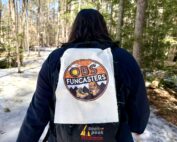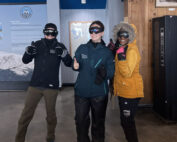As The Seasons Change, So Does The Job
2020-12-28 09:45:10.000 – Nicole Tallman, Weather Observer/Education Specialist
Many have asked me what it is like to live in the “Home of the World’s Worst Weather” in the dead of winter to which I respond it is like living in another world! There are many experiences that winter on Mount Washington allows you to experience that you would never get the chance to do elsewhere. The job of Weather Observer in the winter months vs summer months are quite different in many ways.
First being transportation to the summit. In the summer the Mount Washington Auto Road is open for vehicles to drive from base to summit. It is quite easy for the summit crew to drive up and down in a van for every shift change. Once the shoulder seasons begin the transportation begins to become a bit trickier. We switch over to using chains on the tires once ice and snow begin to cover the road and once the road is covered to a certain level, we begin snowcat season. The snowcat requires a bit more time and preparation to travel up the Auto Road for shift change. As a crew member I sit in the back with my other shift members and we prepare for the slow and steady trip up the mountain. On average this can take anywhere from 45 minutes to an hour and 15 minutes on a good day! This compares to a typical 20 to 30 minute drive up the Auto Road in the summer. I personally love the slow trips up the mountain especially when it is clear! This allows for sightseeing and some awesome photo opportunities. However not all snowcat rides are pleasant. Since the summit is in the fog every 2/3 days and there is also the high likelihood of blowing snow to cause large drifts on the road, sometimes these drives are completely socked in and require a lot of plowing to make it up or down the mountain. These difficult trips can take upwards of 4 hours on a one way commute.
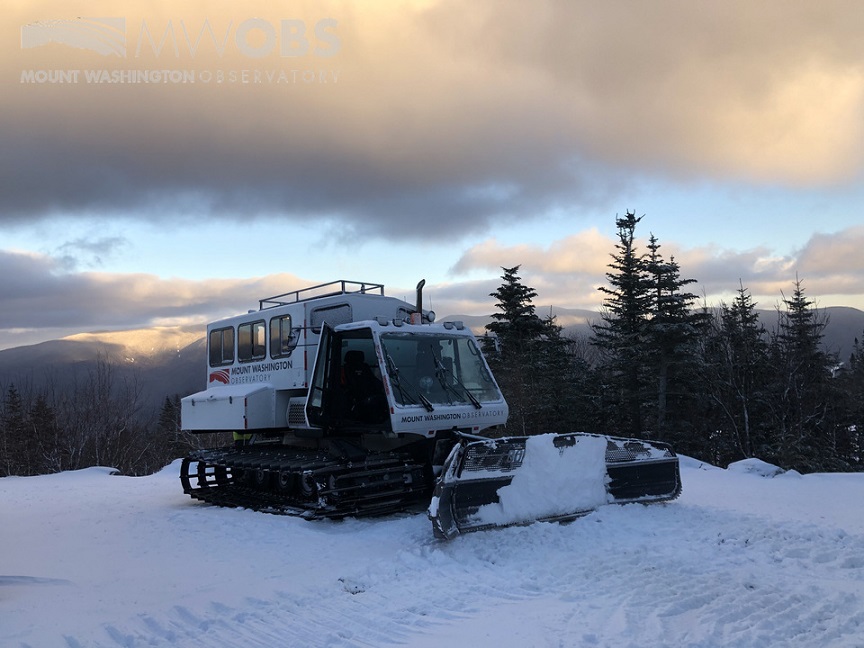
The shift to the winter season also means a shift in precipitation to the various forms of winter precipitation. We as weather observers go from primarily collecting rain to collecting and observing a wide variety of frozen and freezing precipitation. Snow, snow grains, snow pellets, ice pellets, freezing rain and freezing drizzle are some of the main precipitation types we see on the summit. This requires us to be very observant of what type is falling by using a snow board to collect the precipitation for evaluation. Precipitation types can change from one to another or sometimes multiple types will be falling together. It is important for us to determine what type of precipitation is falling because it tells us a lot about the conditions of the atmosphere not only at our elevation but above our heads as well. If you would like to learn more about how these precipitation types occur and the hazards, they can produce you can check out a program that I led on Winter Precipitation as part of the Home of the World’s Worst Weather Live series. Visit Mountwashington.org/classroom to view past programs and register for future programs.
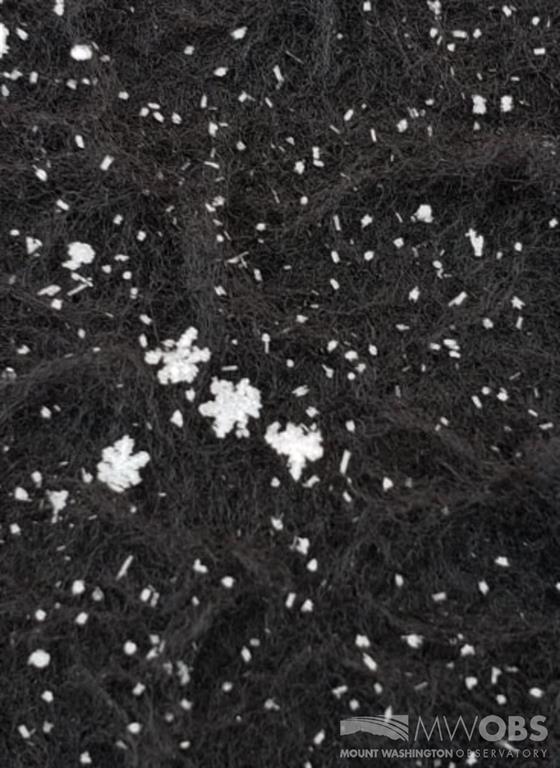
Freezing precipitation, or fog during below freezing temperatures can both cause the accumulation of ice. With the accumulation of both ice and winter precipitation comes the need for shoveling and deicing the instruments. It is a familiar task come wintertime to gear up from head to toe and head out once an hour to ensure that the instruments are ice free. We do this by climbing up a series of ladders to the top of our instrument tower where several anemometers (wind) and thermometers (temperature) are exposed to the elements collecting data. While they are collecting data however, they are also accumulating feathers of rime ice or a shield of glaze ice. It is critical for us as weather observers to maintain these instruments to make sure they are able to capture the most accurate data. The clanging of a metal crow bar becomes a familiar sound once the seasons shift due to the deicing of the tower. This task involves observers exposing themselves to extreme conditions while using a crowbar to dislodge ice that has built upon the instruments and tower. While we are deicing we have to be careful to keep ourselves out of harms way by positioning ourselves out of line of flying ice or extremely high winds. This task can be very difficult depending on the type and speed of accumulation. Glaze ice is very challenging to remove from instruments and requires much more force than rime, however rime can grow at impressive rates! Both types of ice typically require us to deice once an hour but this task can be necessary as often as every 15 minutes when the icing gets bad. Sometimes I stop and think back to the summer months and I wonder how it feels to go a week without deicing!
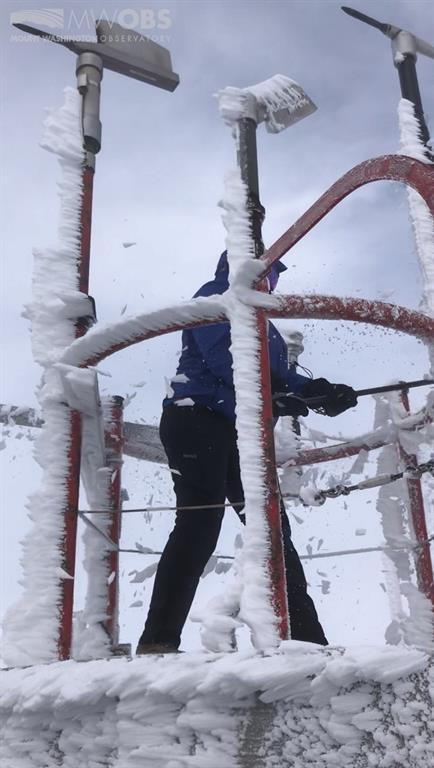
There are also other small changes that come with the shift of the season such as shorter daylight hours. This means that the beginning and end of my shift as a day observer are actually in darkness. I have been able to dip my toes in the water of taking night observations because of this. It is definitely more challenging to observe the weather in the darkness of night than in the daylight like I am used to! It takes a few minutes for your eyes to adjust to the darkness and allow you to make out if there are clouds in the sky or not. Once my eyes are adjusted it still is very challenging to be able to determine heights and types of clouds. I will usually write down what I see outside and once back inside I use satellite images and other visual aids that help me determine what heights the clouds I was seeing were at. Determining visibility is also quite challenging in the dark. In the day, there are plenty of mountain ranges at known distances to determine visibility. However, in the dark we use city lights to help determine visibility since the surrounding mountains can be challenging to see. It is also more difficult to be able to observe certain phenomena like blowing and drifting snow, precipitation in the vicinity or virga. All of these things are easily identified in the day but become more challenging in the dark! Even though these observations are more challenging, I do appreciate the opportunity to experience what it is like to be the night observer.

Living and working on the summit is constantly changing and always keeps you on your toes. Every day the weather changes and poses new challenges and every season is a brand-new experience. I have only been able to experience December on Mount Washington and am looking forward to what the rest of winter on the rockpile has to offer.
Nicole Tallman, Weather Observer/Education Specialist
Team Flags Return for Seek the Peak’s 25th Anniversary
Team Flags Return for Seek the Peak's 25th Anniversary By MWOBS Staff Mount Washington Observatory is looking forward to continuing a much-loved tradition for Seek the Peak’s 25th Anniversary: Team flags. In inviting teams
Meet Summer Interns Zakiya, Max and Maddie
Meet Summer Interns Zakiya, Max and Maddie By MWOBS Staff We are excited to welcome six teammates to the summit of Mount Washington this summer! During their internship, these students and graduates will play
Saying Goodbye to the Summit
Saying Goodbye to the Summit By Alexis George After an extraordinary last three years working as a Weather Observer and Meteorologist, I am excited to pursue a different career. As sad I as am

